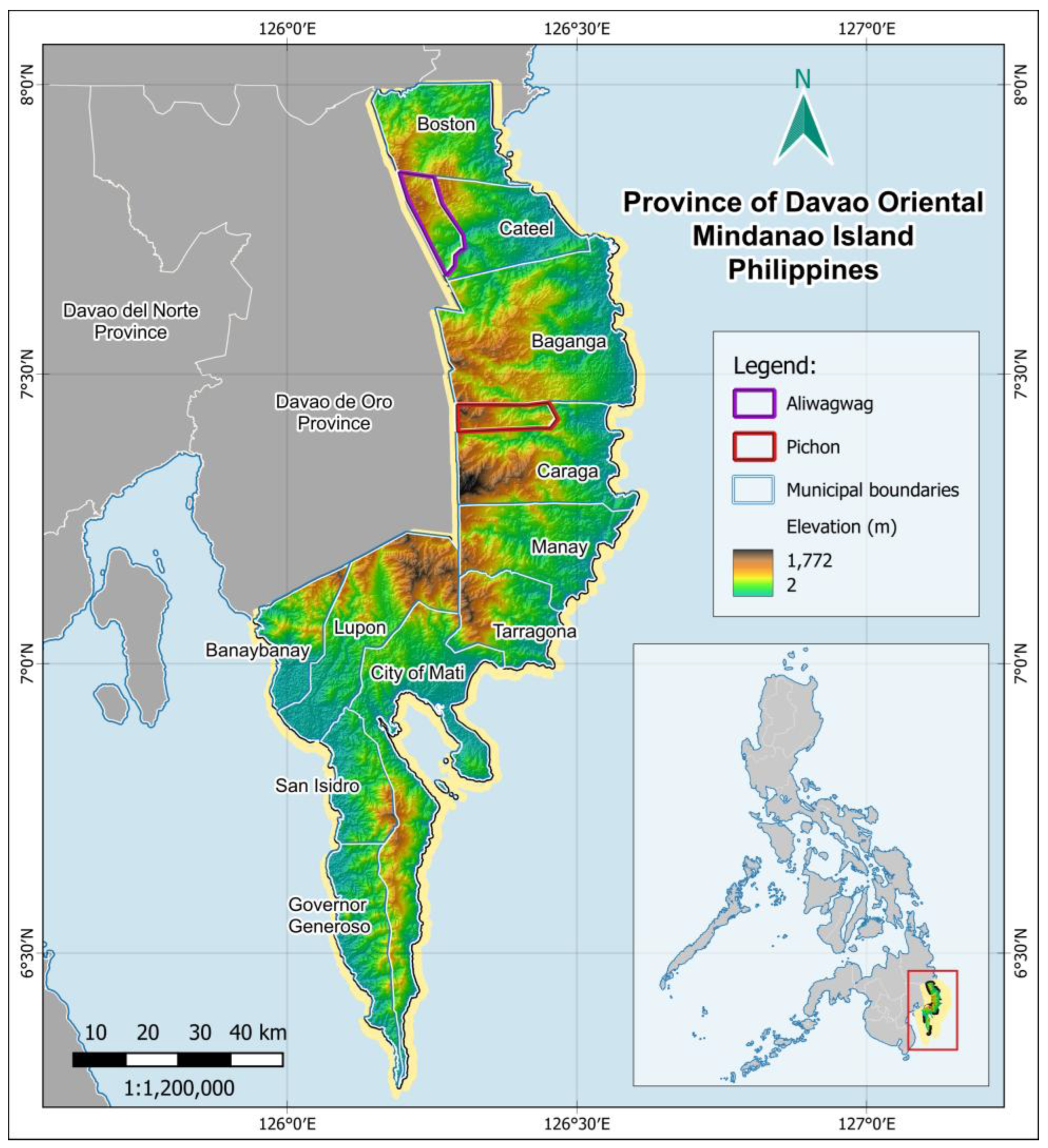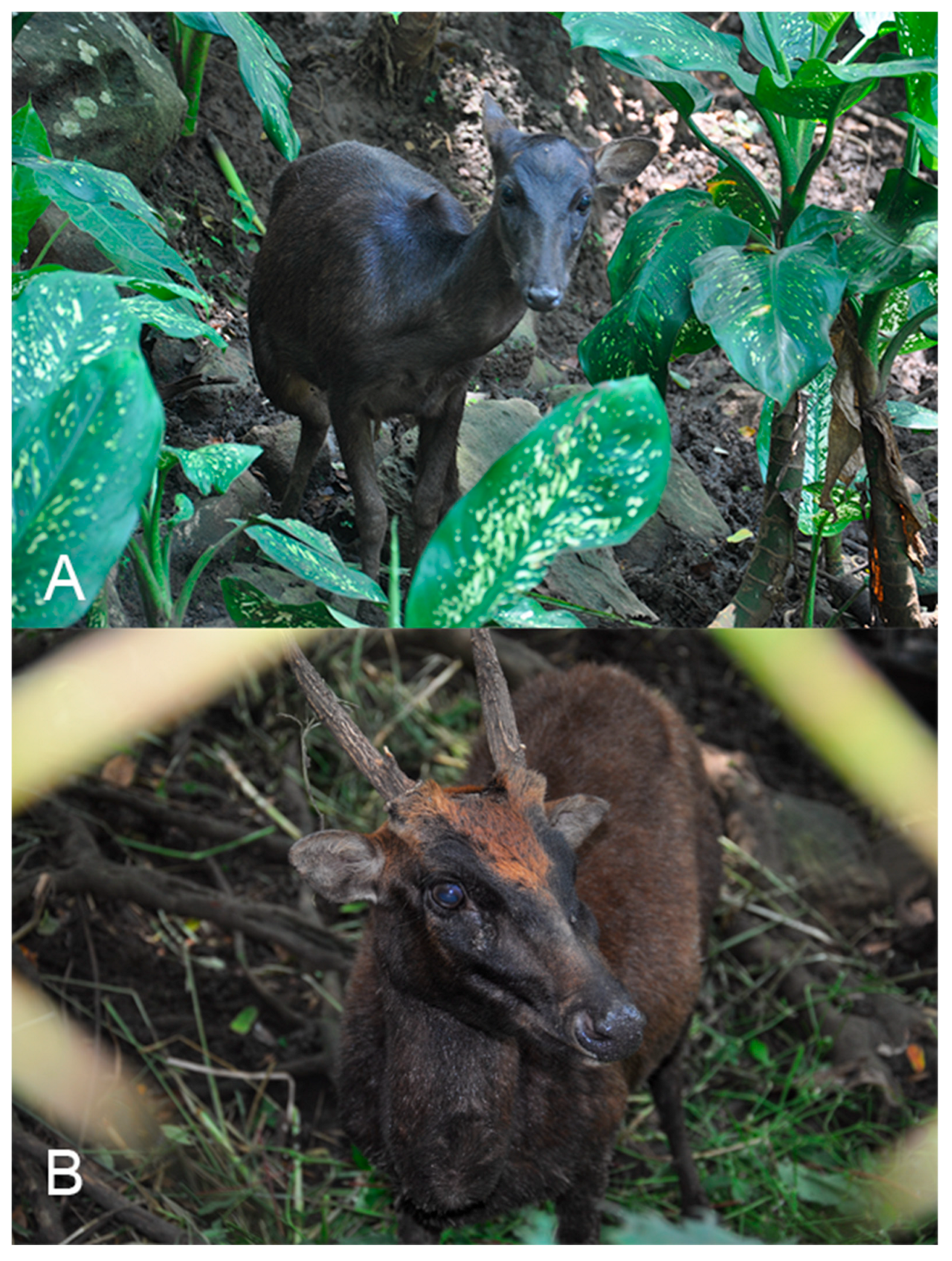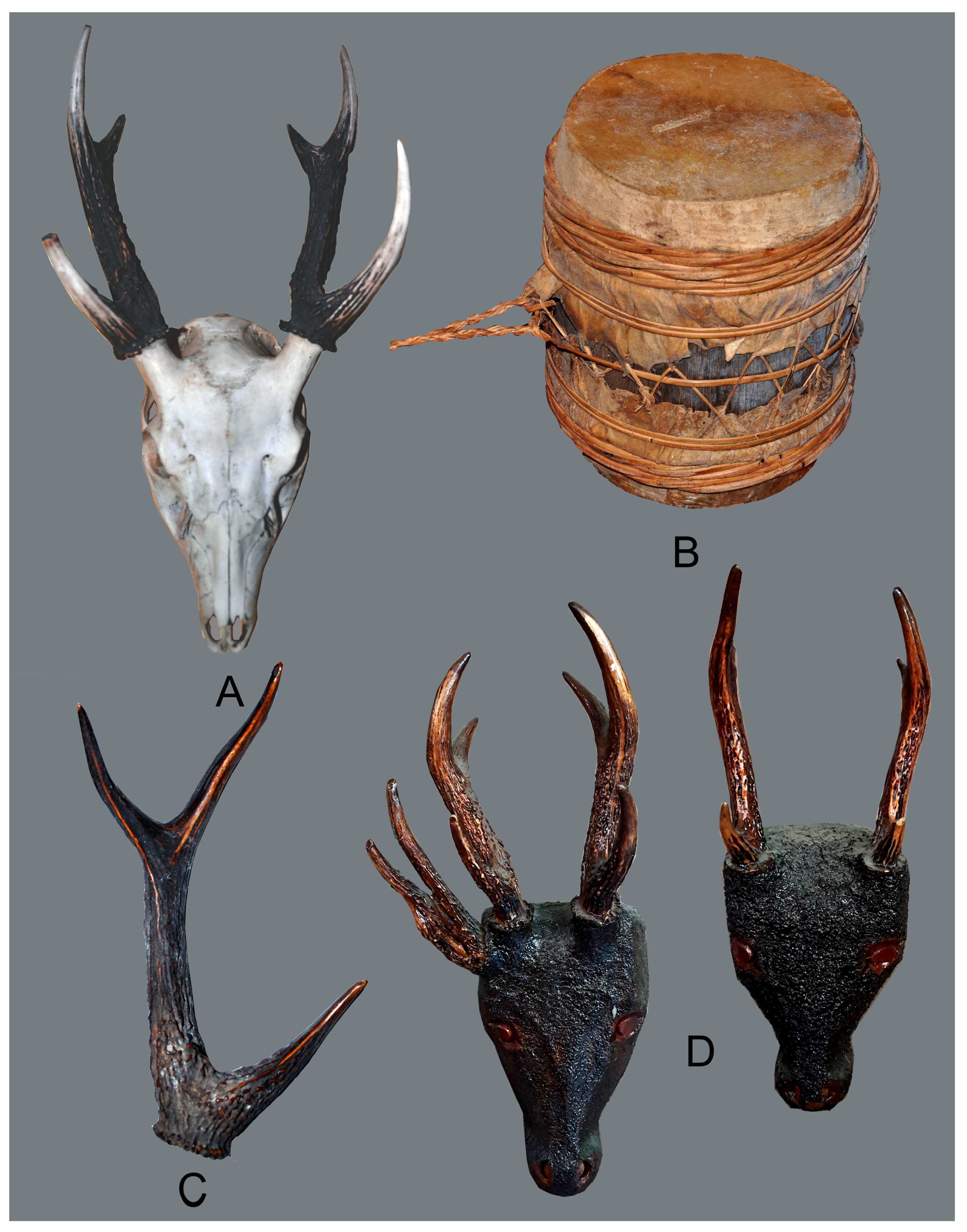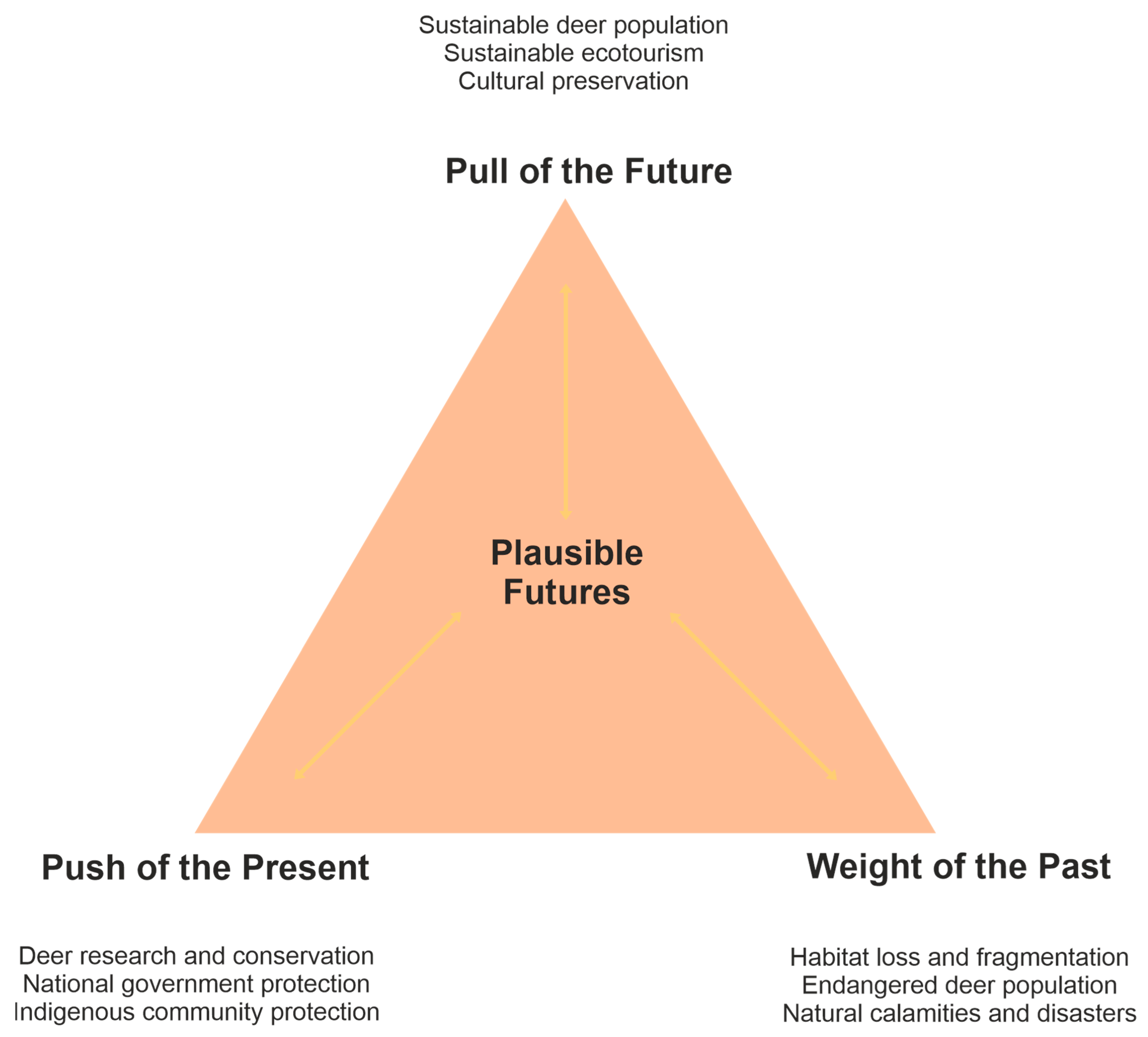Human–Wildlife Interactions: Cultural Sensitivities and Perspectives Influence the Conservation of the Philippine Brown Deer (Rusa marianna Desmarest, 1822)
Simple Summary
Abstract
1. Introduction
2. Methodology
2.1. Study Sites
2.2. Research Design
2.3. Community Interviews
2.4. Research Instrument and Participants
2.5. Thematic Analysis
2.6. Futures Thinking
3. Results
3.1. Indigenous Knowledge
3.2. The Deer in the Mandaya Culture
3.3. Population Status and Threats
3.4. Conservation
3.5. Futures of Deer Conservation
4. Discussion
5. Conclusions
Author Contributions
Funding
Institutional Review Board Statement
Informed Consent Statement
Data Availability Statement
Acknowledgments
Conflicts of Interest
Abbreviations
| APL | Aliwagwag Protected Landscape |
| BMB | Biodiversity Management Bureau |
| CADT | Certificate of Ancestral Domain Title |
| CLA | Causal Layered Analysis |
| DAO | DENR Administrative Order |
| DENR | Department of Environment and Natural Resources |
| E-NIPAS | Expanded National Integrated Protected Areas System |
| EMBC | Eastern Mindanao Biodiversity Corridor |
| FGDs | Focus Group Discussions |
| FMB | Forest Management Bureau |
| FT | Futures Triangle |
| ICCs | Indigenous Cultural Communities |
| IPRA | Indigenous Peoples Rights Act |
| IPs | Indigenous Peoples |
| KII | Key Informant Interviews |
| LGU | Local Government Unit |
| NIPAS | National Integrated Protected Areas System |
| PAMB | Protected Area Management Board |
| PAMO | Protected Area Management Office |
| SWOT | Strengths, Weaknesses, Opportunities, and Threats |
Appendix A. Interview Guide
- What do you know about the Philippine brown deer? (Nyanang kyakasayodan mo sam sol’law na osa disim Banwa ng Pilipinas)
- Morphology (Pagtoon nang kal’lawas aw kaymo nam butang aw bowi)
- Diet and feeding (Pyagakaan o pagkaan)
- Territory and habitat (Paguya)
- Reproduction (Pagdagdag, pagpanganak, pagkadaig)
- Behaviour (Kinaiya)
- What are the cultural beliefs about the Philippine brown deer in your indigenous community? (Nyanang kyakasayudan ta bain nam kanatun kinaiyahan na pagtoo bain sam sol’law na osa nam Pilipinas?)
- What are the ethnozoological uses of the Philippine brown deer in your indigenous community? (Nyanang ‘ethnozoological’ kad’yawan na kyakaatag sang kanatun komunidad nang sol’law na osa ning kanatun banwa nang Pilipinas?)
- What is the population trend of the Philippine brown deer in the CADT-01 over the last 30 years? 20 years? 10 years? (On-nono ing kadaig ng sol’law na osa nam Pilipinas sang CADT-01 disti tol’lompol’lo katuwig?dowampol’lo katuwig? sampol’long ka tuig?)
- Increasing (Gadugang)
- Decreasing (Yagaka katabayda o pyagkakamangan)
- Stable (Madakmol’l o madaigay o ol-la)
- Why do you think there are changes in the Philippine brown deer population? (San tanaw mo nanga al’lon kaisaban nam popolasyon nang sol’law na osa nam Pilipinas?)
- What conservation threats concerning the Philippine brown deer have you observed or documented? (Nyanang iinang mayo na pamaagi antak di mawal’la ing sol’law na osa na kamayo ikita aw pagsol’lat o dolomento?)
- What protection, management, and conservation measures and policies are implemented in your indigenous community? What do you think is being done or should be done? (Nyanang iinang mayo disining kamayo komunidad, na mga pamaagi, san tanaw mo na iinang o inangun antak di matiwas ing mga sol’law na osa?)
- What are the gender roles of women, men, and youth in conserving the Philippine brown deer? (Nanang katungdanan nam kabobayan, kausgan, aw mga sogno antak di mawal’la ing sol’law na osa?)
- What are your policy suggestions and recommendations to protect, manage, and conserve the Philippine brown deer? (Nanang polisiya na aka ambag mo aw sugyot mo antak kabantayan na di matiwas yang sol’law na osa?)
- What are your future perspectives on the conservation of the Philippine brown deer? (Nanang dyudumdum mo o panlantaw mo na mad’yaw inangun antak di matiwas in sol’law na osa?)
References
- Leslie, D.M. Rusa unicolor (Artiodactyla: Cervidae). Mamm. Species 2011, 43, 1–30. [Google Scholar] [CrossRef]
- Geist, V. Three-pronged Old World deer. In Deer of the World: Their Evolution, Behaviour, and Ecology; Geist, V., Ed.; Stackpole Books: Mechanicsburg, PA, USA, 1998; pp. 55–80. [Google Scholar]
- Heckeberg, N.S. The Systematics of Cervidae. In Deer of the World: Ecology, Conservation and Management; Melletti, M., Focardi, S., Eds.; Springer Nature: Cham, Switzerland, 2025; pp. 1–45. [Google Scholar] [CrossRef]
- [DAO 09] Department of Environment and Natural Resources Administrative Order 2019–09. Updated National List of Threatened Philippine Fauna and their Categories. 2019. Available online: https://elibrary.bmb.gov.ph/elibrary/wp-content/uploads/2023/05/dao2019-09.pdf (accessed on 21 October 2024).
- [DENR–BMB] Department of Environment and Natural Resources—Biodiversity Management Bureau. Philippine Red List of Threatened Wild Fauna; Biodiversity Management Bureau (BMB): Quezon, Philippines, 2020.
- MacKinnon, J.R.; Ong, P.; Gonzales, J. Rusa marianna. The IUCN Red List of Threatened Species 2015, e.T4274A22168586. Available online: https://www.iucnredlist.org/species/4274/22168586 (accessed on 9 October 2025).
- Tanalgo, K.C. Wildlife hunting by Indigenous People in a Philippine protected area: A perspective from Mt. Apo National Park, Mindanao Island. J. Threat. Taxa 2017, 9, 10307–10313. [Google Scholar] [CrossRef]
- Villegas, J.P.; Rosales, J.R.; Tampos, G.G.; Ibañez, J.C. Inventory and abundance of non-volant mammals and birds in the unprotected regions of the Mount Apo range, Philippines. J. Threat. Taxa 2023, 15, 22927–22939. [Google Scholar] [CrossRef]
- McShea, W.J.; Ilyas, O.; Li, S.; Duarte, J.M.B. Conservation of Deer in South America and Asia. In Deer of the World: Ecology, Conservation and Management; Melletti, M., Focardi, S., Eds.; Springer Nature: Cham, Switzerland, 2025. [Google Scholar] [CrossRef]
- Villegas, J.P.; Rosales, J.R.; Verzosa, R.C.; Ibañez, J.C.; Ceacero, F. Philippine Brown Deer (Rusa marianna Desmarest, 1822). In Deer of the World: Ecology, Conservation and Management; Melletti, M., Focardi, S., Eds.; Springer Nature: Cham, Switzerland, 2025. [Google Scholar] [CrossRef]
- [DENR–FMB] Department of Environment and Natural Resources—Forest Management Bureau. Philippine Forestry Statistics 2014; Forest Management Bureau (FMB): Quezon, Philippines, 2014.
- [DENR-FMB] Department of Environment and Natural Resources—Forest Management Bureau. Philippine Forestry Statistics 2023; Forest Management Bureau (FMB): Quezon, Philippines, 2023.
- Nikolakis, W.; Gay, V.; Nygaard, A. The ‘environmental stewardship-health nexus’ among Indigenous Peoples: A global systematic literature review. Wellbeing Space Soc. 2023, 4, 100121. [Google Scholar] [CrossRef]
- Palita, S.K.; Panda, D.; Nayak, J.K. Indigenous communities and biodiversity conservation: An Indian perspective. Sci. Cult. 2023, 89, 347–356. [Google Scholar] [CrossRef]
- Sze, J.S.; Childs, D.Z.; Carrasco, L.R.; Fernández-Llamazares, A.; Garnett, S.T.; Edwards, D.P. Indigenous Peoples’ lands are critical for safeguarding vertebrate diversity across the tropics. Glob. Chang. Biol. 2023, 30, e16981. [Google Scholar] [CrossRef]
- Villegas, J.P.; Ibañez, J.C.; Cabrido, C.K.T. Abundance and distribution of the Philippine Brown deer (Rusa marianna Desmarest, 1822) in the Obu Manuvu ancestral domain, Mindanao Island, Philippines. Acta Biol. Univ. Daugavp. 2022, 22, 67–89. [Google Scholar]
- Bauyot, M.F.; Villegas, J.P.; Asaias, V.E. Gender roles of Obu Manuvu women and leaders in the conservation of the Philippine brown deer Rusa marianna Desmarest, 1822. Palawan Sci. 2024, 16, 47–56. [Google Scholar] [CrossRef]
- [TUOMTC] The Unified Obu Manuvu Tribal Council. Caring for Pusaka; Philippine Eagle Conservation Program Foundation: Davao City, Philippines, 2017; 20p. [Google Scholar]
- Nabayra, E.S. Cosmology of the Mandaya. AghamTao 2014, 23, 12–44. Available online: https://pssc.org.ph/wp-content/pssc-archives/Aghamtao/2014/2-Nabayra.pdf (accessed on 9 October 2025).
- Sevilla-Liu, A. The theoretical basis of a functional-descriptive approach to qualitative research in CBS: With a focus on narrative analysis and practice. J. Context. Behav. Sci. 2023, 30, 210–216. [Google Scholar] [CrossRef]
- Reeves, S.; Peller, J.; Goldman, J.; Kitto, S. Ethnography in qualitative educational research: AMEE guide No. 80. Med. Teach. 2013, 35, e1365–e1379. [Google Scholar] [CrossRef]
- Creswell, J.W. Research Design: Qualitative, Quantitative, and Mixed Methods Approaches, 4th ed.; SAGE Publications: Thousand Oaks, CA, USA, 2014. [Google Scholar]
- Kiik, L. Wild-ing the ethnography of conservation: Writing nature’s value and agency in. Anthropol. Forum 2018, 28, 217–235. [Google Scholar] [CrossRef]
- Thaler, G.M. Ethnography of environmental governance: Towards an organizational approach. Geoforum 2021, 120, 122–131. [Google Scholar] [CrossRef]
- Oduor, A.M. Livelihood impacts and governance processes of community-based wildlife conservation in Maasai Mara ecosystem, Kenya. J. Environ. Manag. 2020, 260, 110133. [Google Scholar] [CrossRef]
- Mosse, M.N.; Odadi, W.O.; Kibue, G.W. Anthropogenic threats to crocodiles, and the level and sociodemographic determinants of their utilization in lower river Tana basin, Kenya. Trop. Conserv. Sci. 2024, 17, 1–15. [Google Scholar] [CrossRef]
- Muellmann, S.; Brand, T.; Jürgens, D.; Gansefort, D.; Zeeb, H. How many key informants are enough? Analysing the validity of the community readiness assessment. BMC Res. Notes 2021, 14, 85. [Google Scholar] [CrossRef]
- Rahimi, S.; Khatooni, M. Saturation in qualitative research: An evolutionary concept analysis. Int. J. Nurs. Stud. Adv. 2024, 6, 100174. [Google Scholar] [CrossRef]
- Squires, V. Thematic Analysis. In Varieties of Qualitative Research Methods; Springer: Cham, Switzerland, 2023; pp. 154–196. [Google Scholar] [CrossRef]
- Alam, R.; Nayak, D. Examining human-wildlife conflict and management strategies in Indian protected areas: Evidence from Jim Corbett tiger reserve. Hum. Dimens. Wildl. 2024, 30, 34–51. [Google Scholar] [CrossRef]
- Blackie, I.R.; Gaodirelwe, I.; Masole, C. Wildlife killer instincts: Human wildlife conflict and fatal incidents in Botswana. Cogent Soc. Sci. 2024, 10, 2429795. [Google Scholar] [CrossRef]
- Mupunga, P.; Shoko, J. Local community perceptions on human–wildlife interactions in the face of climate variability: A case of Nyaminyami community, Zimbabwe. Front. Sustain. Tour. 2024, 3, 1328510. [Google Scholar] [CrossRef]
- Asian Development Bank. Futures Thinking in Asia and the Pacific: Why Foresight Matters for Policy Makers. 2020. Available online: https://www.adb.org/sites/default/files/publication/579491/futures-thinking-asia-pacific-policy-makers.pdf (accessed on 21 October 2024).
- Ednie, G.; Kapoor, T.; Koppel, O.; Piczak, M.L.; Reid, J.L.; Murdoch, A.D.; Cook, C.N.; Sutherland, W.J.; Cooke, S.J. Foresight science in conservation: Tools, barriers, and mainstreaming opportunities. Ambio 2022, 52, 411–424. [Google Scholar] [CrossRef] [PubMed]
- Mahajan, S.L.; Tanner, L.; Ahmadia, G.; Becker, H.; DeMello, N.; Fidler, R.; Harborne, A.R.; Jagadish, A.; Mills, M.; Cairney, P.; et al. Accelerating evidence-informed decision-making in conservation implementing agencies through effective monitoring, evaluation, and learning. Biol. Conserv. 2023, 286, 110304. [Google Scholar] [CrossRef]
- Inayatullah, S. Causal Layered Analysis: Poststructuralism as method. Futures 1998, 30, 815–829. [Google Scholar] [CrossRef]
- Inayatullah, S. Causal layered analysis: Theory, conceptual framework and method. In CLA 3.0—Thirty Years of Transformative Research; Tamkang University Press: Taipei, Taiwan, 2022; pp. 3–22. [Google Scholar]
- Inayatullah, S. The futures triangle: Origins and iterations. World Futures Rev. 2023, 15, 112–121. [Google Scholar] [CrossRef]
- Pelletier, J.; Gélinas, N.; Potvin, C. Indigenous perspective to inform rights-based conservation in a protected area of Panama. Land Use Policy 2019, 83, 297–307. [Google Scholar] [CrossRef]
- Dawson, N.M.; Coolsaet, B.; Sterling, E.J.; Loveridge, R.; Gross-Camp, N.D.; Wongbusarakum, S.; Sangha, K.K.; Scherl, L.M.; Phan, H.P.; Zafra-Calvo, N.; et al. The role of Indigenous Peoples and local communities in effective and equitable conservation. Ecol. Soc. 2021, 26, 19. [Google Scholar] [CrossRef]
- Parks, L.; Tsioumani, E. Transforming biodiversity governance? Indigenous Peoples’ contributions to the convention on biological diversity. Biol. Conserv. 2023, 280, 109933. [Google Scholar] [CrossRef]
- Subramanian, S.; Kelemen, E.; De Vos, A.; Krause, T.; Mayhew, M.; Mead, A.; Nuesiri, E.; Perritt, J.; Islar, M.; Amaruzaman, S.; et al. Inclusion in body and mind: Ensuring full participation of Indigenous Peoples and local communities in decisions related to nature. Ecol. Soc. 2025, 30, 13. [Google Scholar] [CrossRef]
- Demetrio, R.A.; Cárdenas León, D.; Delgado, C.; Correa, R.; Espinoza, R.V. Traditional ecological knowledge on stingless bees in two Ashaninka communities in the central rainforest of Peru. Ethnobiol. Conserv. 2025, 14, 1–12. [Google Scholar] [CrossRef]
- Kagnew, B.; Assefa, A.; Mulugeta, M.; Degu, A.; Abebe, W.; Demissew, S. Assessing Indigenous knowledge on diversity, socio-economy, and on-farm management practices of different yam landraces (Dioscorea cayenensis-rotundata complex) for sustainable production in Southern Ethiopia. Ethnobiol. Conserv. 2025, 14, 1–37. [Google Scholar] [CrossRef]
- Moola, F.; Jolly, H.; Borah, J.; Roth, R. The potential for Indigenous-led conservation in urbanized landscapes in Canada. Front. Hum. Dyn. 2024, 6, 1340379. [Google Scholar] [CrossRef]
- Salvador, D.J.; Ibanez, J.C. Ecology and conservation of Philippine eagles. Ornithol. Sci. 2006, 5, 171–176. [Google Scholar] [CrossRef]
- Ibañez, J.C.; Austin, B.; Garnett, S.T. Planning Sustainable Development within Ancestral Domains: Indigenous People’s Perceptions in the Philippines. In Indigenous People and Economic Development, 1st ed.; Routledge: London, UK, 2016; pp. 141–180. [Google Scholar] [CrossRef]
- Jolly, H.; Stronza, A. Insights on human−wildlife coexistence from social science and Indigenous and traditional knowledge. Conserv. Biol. 2025, 39, e14460. [Google Scholar] [CrossRef]
- Republic Act No. 8371. Official Gazette of the Republic of the Philippines. 1997. Available online: https://www.officialgazette.gov.ph/1997/10/29/republic-act-no-8371/ (accessed on 9 October 2025).
- Camacho, L.D.; Gevaña, D.T.; Carandang, A.P.; Camacho, S.C. Indigenous knowledge and practices for the sustainable management of Ifugao forests in Cordillera, Philippines. Int. J. Biodivers. Sci. Ecosyst. Serv. Manag. 2015, 12, 5–13. [Google Scholar] [CrossRef]
- Ongpin, R.F.; Timones, E.M. A Legal Assessment of the Protection of Indigenous Knowledge Against Biopiracy in the Philippines and ASEAN. De La Salle University. 2017. Available online: https://www.dlsu.edu.ph/wp-content/uploads/pdf/conferences/research-congress-proceedings/2017/SEP/SEP-II-014.pdf (accessed on 9 October 2025).
- Maraña, E.C.; Arpon, R.A.; Capuchino, I.L.; Casiño, R.A.; Casuga, K.R.; Aguilar, J.G. Strengthening of best practices in the preservation of cultural diversities: A phenomenological research. GSC Adv. Res. Rev. 2023, 15, 046–062. [Google Scholar] [CrossRef]
- Jonsson, F.A. The origins of Cornucopianism: A preliminary genealogy. Crit. Hist. Stud. 2014, 1, 151–168. [Google Scholar] [CrossRef]
- Dalagan, R.; Hadia, C.N.; Bayacag, J. Bayok of the Mandaya as a tool for disseminating messages on El Niño phenomenon. Davao Res. J. 2000, 3, 48–56. [Google Scholar] [CrossRef]
- Camacho, L.D.; Combalicer, M.S.; Yeo-Chang, Y.; Combalicer, E.A.; Carandang, A.P.; Camacho, S.C.; De Luna, C.C.; Rebugio, L.L. Traditional forest conservation knowledge/technologies in the Cordillera, northern Philippines. For. Policy Econ. 2012, 22, 3–8. [Google Scholar] [CrossRef]
- Panopio, J.K.; Pajaro, M.; Grande, J.M.; Torre, M.D.; Raquino, M.; Watts, P. Conservation letter: Deforestation—The Philippine eagle as a case study in developing local management partnerships with Indigenous Peoples. J. Raptor. Res. 2021, 55, 658. [Google Scholar] [CrossRef]
- Hare, D.; Daniels, M.; Blossey, B. Public perceptions of deer management in Scotland. Front. Conserv. Sci. 2021, 2, 781546. [Google Scholar] [CrossRef]
- Ma, H.; Zhang, D.; Xiao, L.; Wang, Y.; Zhang, L.; Thompson, C.; Chen, J.; Dowell, S.D.; Axmacher, J.C.; Lü, Z.; et al. Integrating biodiversity conservation and local community perspectives in China through human dimensions research. People Nat. 2022, 4, 1461–1474. [Google Scholar] [CrossRef]
- Cachipuendo, C.; Pilataxi, S. The Chakana: A symbol of the Andean worldview in community water management, and a form of governance of life. Ecol. Soc. 2025, 30, 324. [Google Scholar] [CrossRef]
- Limbaro, G.R.; Villareal, J.F.; Poclis-Villareal, C.E.; Santillan, R.D.; de Vera, P.J. Understanding attitudes to urban tree conservation in Mindanao Island, Philippines. Arboric. J. 2024, 1–21. [Google Scholar] [CrossRef]
- Villegas, J.P.; Clarido, A.P.; Enobio, V.D.; Lumpapac, J.D.; Ibañez, J.C. Local perception, values, and conservation attitude towards Brahminy kites (Haliastur indus Boddaert, 1783) in Tugbok district, Davao City, Philippines. Asian J. Biodivers. 2021, 12, 23–35. [Google Scholar] [CrossRef]
- Catibog-Sinha, C. The food preference of the Philippine deer (Cervus philippinus Smith, 1987) in captivity. Sylvatrop 1986, 11, 95–101. [Google Scholar]
- Catibog-Sinha, C. Female reproduction and parturition in penned Philippine deer (Cervus unicolor philippinus Smith). Philipp. J. Sci. 1989, 118, 19–30. [Google Scholar]
- Catibog-Sinha, C. How to raise Philippine deer in captivity. In A Monograph on the Philippine Deer: Debt-for-Nature Swap Project; Department of Environment and Natural Resources (DENR): Quezon City, Philippines, 1993; pp. 61–72. [Google Scholar]
- Mattioli, S. Family Cervidae (Deer). In Handbook of the Mammals of the World; Wilson, D.E., Mittermeier, R.A., Eds.; Lynx Edicions: Barcelona, Spain, 2011; Volume 2. [Google Scholar]
- Heaney, L.R.; Balete, D.S.; Rickart, E.A. The Mammals of Luzon Island: Biogeography and Natural History of a Philippine Fauna; JHU Press: Baltimore, MD, USA, 2016. [Google Scholar]
- Smith-Jones, C. A Guide to the Deer of the World, 3rd ed.; Stackpole Books: Mechanicsburg, PA, USA, 2023. [Google Scholar]
- Melletti, M.; Focardi, S. Deer of the World: Ecology, Conservation and Management; Springer Nature: Cham, Switzerland, 2025. [Google Scholar] [CrossRef]
- Verschueren, S.; Bauer, H.; Cristescu, B.; Leirs, H.; Torres-Uribe, C.; Marker, L. From popularity to preservation: Large carnivore potential for ecosystem conservation. Mammal Rev. 2024, 55, e12365. [Google Scholar] [CrossRef]
- Edge Davao. Davao Region’s First Wildlife Rescue Center to Rise Soon. 2011. Available online: https://edgedavao.net/suburbia/2011/07/davao-regions-first-wildlife-rescue-center-to-rise-soon/ (accessed on 26 November 2024).
- Arnett, E.B.; Southwick, R. Economic and social benefits of hunting in North America. Int. J. Environ. Stud. 2015, 72, 734–745. [Google Scholar] [CrossRef]
- Matejević, M.; Marković, V.; Kalábová, M.; Ristić, Z.; Kovačević, M.; Ponjiger, I.; Popović, I. Economic impact of Roe deer tourist hunts in Vojvodina (Serbia). Cent. Eur. For. J. 2023, 69, 31–37. [Google Scholar] [CrossRef]
- International Society of Ethnobiology. ISE Code of Ethics (with 2008 Additions). 2006. Available online: http://ethnobiology.net/code-of-ethics/ (accessed on 28 April 2025).





| Strengths | Weaknesses |
|
|
| Opportunities | Threats |
|
|
Disclaimer/Publisher’s Note: The statements, opinions and data contained in all publications are solely those of the individual author(s) and contributor(s) and not of MDPI and/or the editor(s). MDPI and/or the editor(s) disclaim responsibility for any injury to people or property resulting from any ideas, methods, instructions or products referred to in the content. |
© 2025 by the authors. Licensee MDPI, Basel, Switzerland. This article is an open access article distributed under the terms and conditions of the Creative Commons Attribution (CC BY) license (https://creativecommons.org/licenses/by/4.0/).
Share and Cite
Villegas, J.P.; Pua, L.R.; Vidláková, A.; Ceacero, F. Human–Wildlife Interactions: Cultural Sensitivities and Perspectives Influence the Conservation of the Philippine Brown Deer (Rusa marianna Desmarest, 1822). Animals 2025, 15, 3397. https://doi.org/10.3390/ani15233397
Villegas JP, Pua LR, Vidláková A, Ceacero F. Human–Wildlife Interactions: Cultural Sensitivities and Perspectives Influence the Conservation of the Philippine Brown Deer (Rusa marianna Desmarest, 1822). Animals. 2025; 15(23):3397. https://doi.org/10.3390/ani15233397
Chicago/Turabian StyleVillegas, Jhonnel P., Lenilyn R. Pua, Aneta Vidláková, and Francisco Ceacero. 2025. "Human–Wildlife Interactions: Cultural Sensitivities and Perspectives Influence the Conservation of the Philippine Brown Deer (Rusa marianna Desmarest, 1822)" Animals 15, no. 23: 3397. https://doi.org/10.3390/ani15233397
APA StyleVillegas, J. P., Pua, L. R., Vidláková, A., & Ceacero, F. (2025). Human–Wildlife Interactions: Cultural Sensitivities and Perspectives Influence the Conservation of the Philippine Brown Deer (Rusa marianna Desmarest, 1822). Animals, 15(23), 3397. https://doi.org/10.3390/ani15233397








